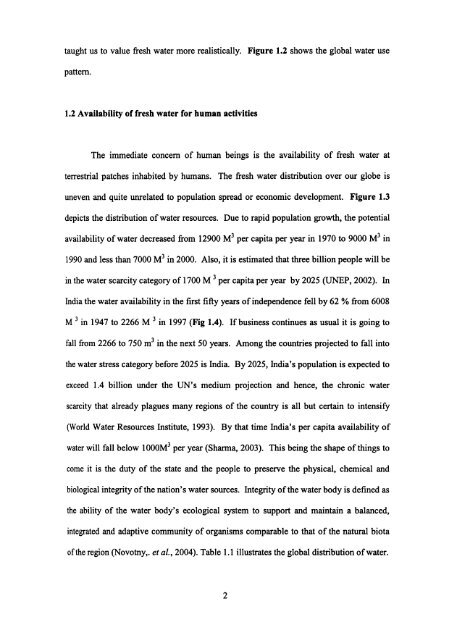Salinity Intrusion and Seasonal Water Quality Variations in the Tidal ...
Salinity Intrusion and Seasonal Water Quality Variations in the Tidal ...
Salinity Intrusion and Seasonal Water Quality Variations in the Tidal ...
You also want an ePaper? Increase the reach of your titles
YUMPU automatically turns print PDFs into web optimized ePapers that Google loves.
taught us to value fresh water more realistically. Figure 1.2 shows <strong>the</strong> global water use<br />
pattern.<br />
1.2 Availability offresh water for human activities<br />
The immediate concern of human be<strong>in</strong>gs is <strong>the</strong> availability of fresh water at<br />
terrestrial patches <strong>in</strong>habited by humans. The fresh water distribution over our globe is<br />
uneven <strong>and</strong> quite unrelated to population spread or economic development. Figure 1.3<br />
depicts <strong>the</strong> distribution ofwater resources. Due to rapid population growth, <strong>the</strong> potential<br />
availability ofwater decreased from 12900 M 3 per capita per year <strong>in</strong> 1970 to 9000 M 3 <strong>in</strong><br />
1990 <strong>and</strong> less than 7000 M 3 <strong>in</strong> 2000. Also, it is estimated that three billion people will be<br />
<strong>in</strong> <strong>the</strong> water scarcity category of 1700 M 3 per capita per year by 2025 (UNEP, 2002). In<br />
India <strong>the</strong> water availability <strong>in</strong> <strong>the</strong> first fifty years of<strong>in</strong>dependence fell by 62 % from 6008<br />
M 3 <strong>in</strong> 1947 to 2266 M 3 <strong>in</strong> 1997 (Fig 1.4). If bus<strong>in</strong>ess cont<strong>in</strong>ues as usual it is go<strong>in</strong>g to<br />
fall from 2266 to 750 m 3 <strong>in</strong> <strong>the</strong> next 50 years. Among <strong>the</strong> countries projected to fall <strong>in</strong>to<br />
<strong>the</strong> water stress category before 2025 is India. By 2025, India's population is expected to<br />
exceed 1.4 billion under <strong>the</strong> UN's medium projection <strong>and</strong> hence, <strong>the</strong> chronic water<br />
scarcity that already plagues many regions of <strong>the</strong> country is all but certa<strong>in</strong> to <strong>in</strong>tensify<br />
(World <strong>Water</strong> Resources Institute, 1993). By that time India's per capita availability of<br />
water will fall below 1000M 3 per year (Shanna, 2003). This be<strong>in</strong>g <strong>the</strong> shape ofth<strong>in</strong>gs to<br />
come it is <strong>the</strong> duty of <strong>the</strong> state <strong>and</strong> <strong>the</strong> people to preserve <strong>the</strong> physical, chemical <strong>and</strong><br />
biological <strong>in</strong>tegrity of<strong>the</strong> nation's water sources. Integrity of<strong>the</strong> water body is def<strong>in</strong>ed as<br />
<strong>the</strong> ability of <strong>the</strong> water body's ecological system to support <strong>and</strong> ma<strong>in</strong>ta<strong>in</strong> a balanced,<br />
<strong>in</strong>tegrated <strong>and</strong> adaptive community of organisms comparable to that of <strong>the</strong> natural biota<br />
of<strong>the</strong> region (Novotny,. et al., 2004). Table 1.1 illustrates <strong>the</strong> global distribution ofwater.<br />
2

















